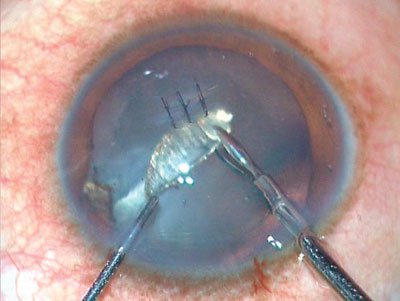How to manage the complications of a traumatic cataract
Cataract surgery may be more challenging, but good results can be achieved.
 Amar Agarwal |
Ocular trauma is known to be associated with cataractous changes in the lens. Direct injury of the crystalline lens can occur through penetrating injury or blunt trauma of the globe. Depending upon the nature of lens opacification and involvement of the visual axis, the symptoms are prominent.
Management of these traumatic cataracts can be complicated by the presence of preoperative zonular dialysis, posterior capsular tear, coexisting trauma to the iris or cornea, and poor visualization due to media haze. These can pose difficulties in successful cataract removal, leading to synechiae, nondilating pupil, intraoperative dialysis, nucleus drop, vitreous loss or hyphema. Cataract surgery in such a situation to give best possible vision for the patient becomes challenging but not impossible.
In this column, we will discuss the complications in traumatic cataract and management of corneal perforation with cataract.
Primary or secondary cataract removal
There are two basic questions concerning the surgery of traumatic cataract: Should primary or secondary cataract removal be performed, and what is the most proper technique if the intervention is decided? Conservative management with lens preservation is followed especially to preserve accommodative potential in young patients unless there is significant vision loss or sight-threatening complications due to an intraocular foreign body (Figure 1). In eyes with perforating injuries, if the lens damage is clear and extensive with cortical material in the anterior chamber, lens removal is performed at the same time as repair of the corneal laceration, termed as the primary procedure (Figures 2a and 2b). The other option is the secondary procedure, in which the corneal laceration repair is performed initially, followed by cataractous lens removal with or without IOL implantation after a short time interval.
 Figure 1. Corneal penetrating trauma with an intraocular foreign body and traumatic cataract. Images: Agarwal A |
 Figures 2A and 2B. A: Corneal perforation repair done with 10-0 nylon. B: Main port made with keratome for cataract removal. |
Surgical management
The surgery should be performed under peribulbar anesthesia in adults. However, general anesthesia may be required in uncooperative pediatric patients and in open-globe injuries.
Incision and rhexis
A clear corneal or scleral tunnel incision can be made. A partial thickness scleral tunnel is made 1.5 mm posterior to the surgical limbus. The sclera is dissected forward with a crescent blade up to 1.5 mm inside the corneal tissue from the limbus. The anterior chamber is reached with a 2.8 mm to 3.2 mm disposable keratome. Viscoelastic is used to maintain the anterior chamber. Capsulorrhexis is performed as in routine cataract surgery with a 26-gauge bent cystotome or rhexis forceps (Figures 3a and 3b). If a pre-existing tear in the anterior capsule is present, one can follow the margin and complete it. Trypan blue is used to stain the capsule in white cataracts, which makes the procedure simple. In a thick fibrotic anterior capsule, Vannas scissors may be required to initially make the opening in the capsule.
 Figures 3A and 3B. A: Siderosis with cataract. B: Capsulorrhexis is completed with forceps. |
Lens removal
A Simcoe cannula can be used to aspirate soft cataracts. However, thick cataracts require aspiration and vacuum settings of phacoemulsification. Thick membrane cataracts may be removed after an initial cut with Vannas scissors followed by manual removal using forceps. Another option is to remove the membrane with a vitrectomy cutter. Extracapsular cataract extraction with primary IOL implantation can also be carried out safely, even in traumatic cataract eyes. After capsulotomy, the limbal incision can be extended, and the nucleus can be delivered with a Vectis lens. Pars plana lensectomy and vitrectomy with IOL implantation is the other option that can be performed as a primary procedure.
Existing zonular defect, pupil deformities
Care must be taken, especially in the performance of the capsulorrhexis and cortical removal steps, not to further weaken already compromised zonular support. If zonular dialysis was noted on the table, one can use capsular tension rings for stabilization.
Pre-existing posterior synechiae with a miotic pupil can be released with visco-cannula. However, in difficult cases, sphincterotomy can be performed. A persistent nondilating pupil can be enlarged with iris hooks or retractors. The Malyugin ring is a new dilating device that has been used to dilate the pupil intraoperatively. In eyes with intraoperative miosis with a posterior capsule rupture, an IOL can be implanted with pupil expansion through Agarwal’s modified Malyugin ring method.
IOL implantation
In the presence of a posterior capsular tear with a good capsular bag, the IOL can be placed in the bag. For a small posterior capsule rupture with no vitreous loss and a good capsular bag, a foldable IOL can be placed. A glued IOL can be performed in cases with deficient posterior capsule.
Postoperative outcome
The common reasons for decreased postoperative vision are corneal scar, retinal scar or macular pucker. Posterior capsule opacification can also occur. There is a higher incidence of uveitis and optic capture in eyes with an IOL in the sulcus than in eyes with an IOL in the bag.
Conclusion
If lens damage is clear and extensive with cortical material in the anterior chamber, which may cause increased IOP or severe inflammatory reaction, lens removal should be performed at the same time as repair of the corneal laceration. Secondary lens removal may be indicated in cases of severe corneal trauma with marked edema.

- Amar Agarwal, MS, FRCS, FRCOphth, is director of Dr. Agarwal’s Eye Hospital and Eye Research Centre. Prof. Agarwal is the author of several books published by SLACK Incorporated, publisher of Ocular Surgery News, including Phaco Nightmares: Conquering Cataract Catastrophes, Bimanual Phaco: Mastering the Phakonit/MICS Technique, Dry Eye: A Practical Guide to Ocular Surface Disorders and Stem Cell Surgery and Presbyopia: A Surgical Textbook. He can be reached at 19 Cathedral Road, Chennai 600 086, India; fax: 91-44-28115871; e-mail: dragarwal@vsnl.com; Web site: www.dragarwal.com.
